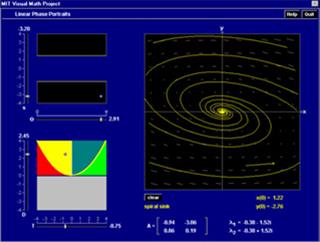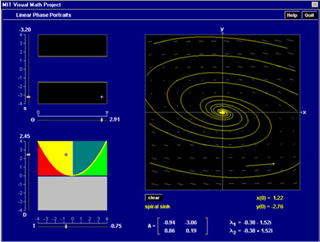معادلات دیفرانسیل دانشگاه MIT

- قیمت: ۵۴/۰۰۰ تومان
- تعداد بازدید: ۶/۲۱۸ بازدید
- زبان: نا معلوم
- تعداد: ۲ حلقه
درس معادلات دیفرانسیل دانشگاه mit
زبان :انگلیسی
تعداد:2 dvd
کد درس:18.03

معادلات دیفرانسیل علمی است که در قوانین طبیعت به وسیله آن تشریح می شود.توانایی درک معادلات دیفرانسیل، یش نیاز بسیاری از رشته های پایه و مهندسی است.معادلات دیفرانسیل مرتبه اول با معادلاتی با یک متغیر سر و کار دارد.
در این مجموعه با مباحث زیر آشنا خواهید شد
حل معادلات دیفرانسیل مرتبه اول به وسیله روشهای تحلیلی،هندسی و عددی - معادلات دیفرانسیل خطی به خصوص معادلات مرتبه دوم همراه با ضریب ثابت - تعیین ضریب و تغییرات پارامتر ها - سیگنالهای سینوسی و نمایی - نوسان ها -شیب اعداد مختلط و نمایی -سری فوریه - راه حل های تناوبی -توابع دلتا -کانولوشن و روشهای تبدیل لاپلاس - ماتریس ها و سیستم های مرتبه اول خطی -نمودار های فاز و ...
این درس در پاییز 2006 در دانشگاه mit توسط پروفسور arthur mattuck و پروفسور haynes miller برای دانشجویان دوره لیسانس تدریس شده است.
ویدیو های آموزشی این درس به فرمت m4v بوده و کیفیت بالایی دارند.فایل های متن صحبت های استاد هم به همراه یادداشتهای درس ضمیمه این مجموعه می باشد.
این درس در 33 جلسه تدریس شده است.
عنوان درسهای تدریس شده به صورت زیر است:
1 the geometrical view of y'=f(x,y): direction fields, integral curves.
2 euler's numerical method for y'=f(x,y) and its generalizations.
3 solving first-order linear ode's; steady-state and transient solutions.
4 first-order substitution methods: bernouilli and homogeneous ode's.
5 first-order autonomous ode's: qualitative methods, applications.
6 complex numbers and complex exponentials.
7 first-order linear with constant coefficients: behavior of solutions, use of complex methods.
8 continuation; applications to temperature, mixing, rc-circuit, decay, and growth models.
9 solving second-order linear ode's with constant coefficients: the three cases.
10 continuation: complex characteristic roots; undamped and damped oscillations.
11 theory of general second-order linear homogeneous ode's: superposition, uniqueness, wronskians.
12 continuation: general theory for inhomogeneous ode's. stability criteria for the constant-coefficient ode's.
13 finding particular sto inhomogeneous ode's: operator and solution formulas involving ixponentials.
14 interpretation of the exceptional case: resonance.
15 introduction to fourier series; basic formulas for period 2(pi).
16 continuation: more general periods; even and odd functions; periodic extension.
17 finding particular solutions via fourier series; resonant terms; hearing musical sounds.
19 introduction to the laplace transform; basic formulas.
20 derivative formulas; using the laplace transform to solve linear ode's.
21 convolution formula: proof, connection with laplace transform, application to physical problems.
22 using laplace transform to solve ode's with discontinuous inputs.
23 use with impulse inputs; dirac delta function, weight and transfer functions.
24 introduction to first-order systems of ode's; solution by elimination, geometric interpretation of a system.
25 homogeneous linear systems with constant coefficients: solution via matrix eigenvalues (real and distinct case).
26 continuation: repeated real eigenvalues, complex eigenvalues.
27 sketching solutions of 2x2 homogeneous linear system with constant coefficients.
28 matrix methods for inhomogeneous systems: theory, fundamental matrix, variation of parameters.
29 matrix exponentials; application to solving systems.
30 decoupling linear systems with constant coefficients.
31 non-linear autonomous systems: finding the critical points and sketching trajectories; the non-linear pendulum.
32 limit cycles: existence and non-existence criteria.
33 relation between non-linear systems and first-order ode's; structural stability of a system, borderline sketching cases; illustrations using volterra's equation and principle.


